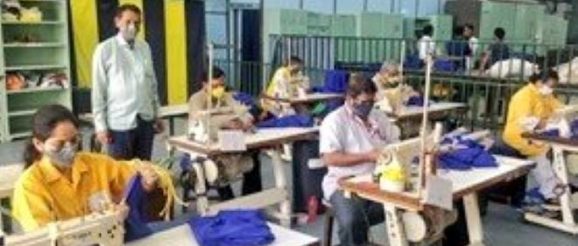Beating coronavirus with innovation! Naval Dockyards develops IR thermometer, PPE gear, other lifesaving tools – The Financial Express

 Indian Navy’s Mumbai Naval Dockyard started producing PPE. (Image: Twitter/Indian Navy)
Indian Navy’s Mumbai Naval Dockyard started producing PPE. (Image: Twitter/Indian Navy)From maintaining hundreds of ships and submarines in harsh sea conditions, Indian Naval Dockyard has come forward to lend a helping hand in the fight against COVID-19.
According to a senior Indian Navy officer, “The warships and submarines are highly technical sea-going crafts which are fitted with high grade propulsion systems and missile systems like SAMs and SSMs that are based on the latest cutting-edge technology.” And, “to maintain the equipment in fighting conditions all the time, there are highly skilled and specialised manpower of different Repair Centres forming part of a Naval Dockyard. They undertake a stringent maintenance and repairs work onboard warships and submarines.”
Each Work Centre has all the repair gadgets and tools, including various standalone or integrated test benches to QC clear the item before it is shifted for onboard fitment.
According to the official spokesperson of the Indian Navy, “For the screening of a huge number of personnel at the entry gates, Naval Dockyard, Mumbai has designed and developed its own handheld IR-based temperature sensor. By using this, the load on the security sentries at the gate will be reduced.”
The manufacturing cost is a fraction of the market cost and this has been possible through in-house resources which comes up to Rs 1,000.
Naval Dockyard, Mumbai is a 285-year-old dockyard under the Western Naval Command. It has an average influx of around 20,000 personnel entering every day. The initial screening of personnel due to the COVID-19 outbreak was putting a lot of pressure on the security staff.
What has the Dockyard designed?
“Handheld IR-based temperature sensor has an accuracy of 0.02 degree Celsius. There is an Infrared sensor and LED display, which is integrated with a microcontroller. This runs on a 9-volt battery,” says the Indian Navy.
If need be, the Naval Dockyard has the capability to scale up production of these handheld sensors which can be used not only by the military facilities but can also be given to the civil administration.
More Innovations by Naval Dockyard
Portable Multi-feed Oxygen Manifold
Recently, the Naval Dockyard unveiled an in-house designed ‘Portable Multi-feed Oxygen Manifold (MOM)’. This uses a 6-way radial header fitted to a single oxygen cylinder. According to the Indian Navy this design allows the use of a single oxygen bottle for six patients at a time, thus helping in maximising the use of critical medical devices in this fight against COVID-19.
Nasal Swabs
Milind Kulshreshtha, C4I expert, says, “There are a lot more items that can be engineered and produced by the Naval Dockyards. For instance, the nasopharyngeal swab or culture that is used by medical staff to collect a sample from the uppermost part of the throat (behind the nose). The sample is collected and sealed in a vial which is further sent for COVID testing. These nasal swabs are always required in large numbers for enhancing testing in the population.”
Components of Mask and Face Shield
“As part of PPE, there is a demand for various components of masks and face shields which too can be manufactured and supplied by the Naval Dockyard to meet the crisis being faced by the shortage. The face shields provide protection of the mucous membranes of the eyes, nose and mouth as an integral part of standard and contact precautions. Naval Dockyard can consider engineering these face shields for manufacturing,” says the C4I expert.
Personal Protective Equipment (PPE) gear
According to Kulshreshtha, “Using the highly skilled manpower production of PPE gear in bulk including the coverall, headcover and shoe cover can be produced at the dockyard. Coverall or gowns protect the torso of healthcare personnel from exposure to virus.”
Handsfree Door Opener
“COVID-19 is known to be also transmitted by direct touch and through contaminated surfaces or objects followed by touching of own mouth, nose, or eyes. The existing door handles have a requirement to be turned open using hand. This risk can be minimized by attaching a small component to the existing door handle piece so that handle can be operated by using arms, ideally with sleeves covered,” he concludes.
Get live Stock Prices from BSE and NSE and latest NAV, portfolio of Mutual Funds, calculate your tax by Income Tax Calculator, know market’s Top Gainers, Top Losers & Best Equity Funds. Like us on Facebook and follow us on Twitter.
